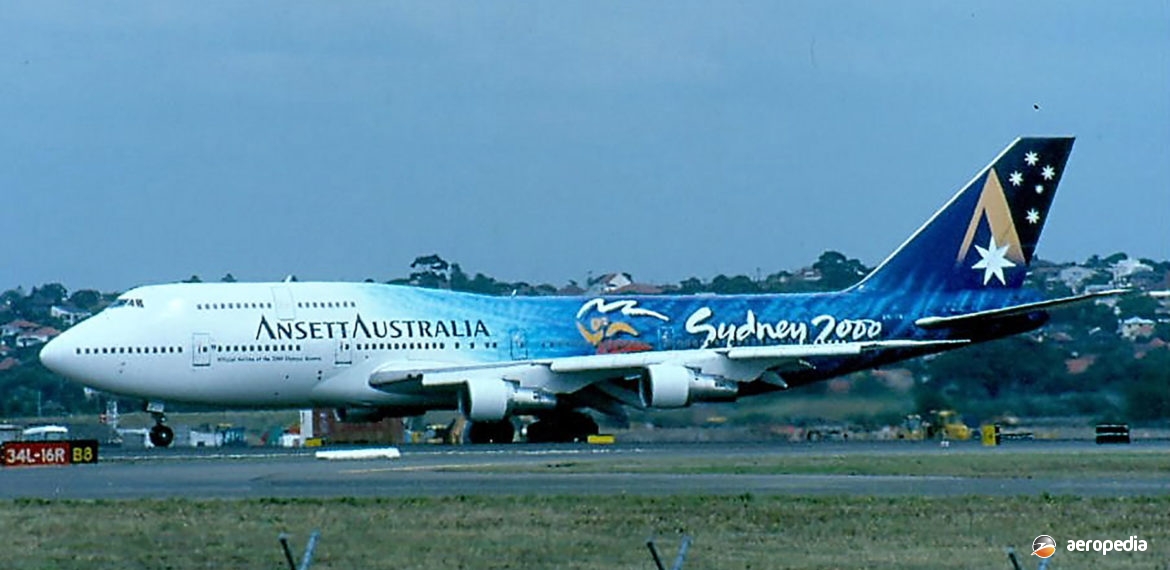Photograph:
Boeing 747-312 VH-INJ (c/n 23029) at Mascot, NSW in December 1997 (David C Eyre)
Country of origin:
United States of America
Description:
Long-range commercial transport
Power Plant:
Four 54,750 lbst Pratt & Whitney JT9D-7R4G2 turbofans; or
Four 52,500 lbst General Electric CF6-50E2 turbofans; or
Four 53,110 lbst Rolls Royce RB211-524D4 turbofans
Specifications:
- Wingspan: 59.64 m (195 ft 8 in)
- Length: 70.66 m (231 ft 10 in)
- Height: 19.33 m (63 ft 5 in)
- Wing area: 511 m² (5,500 sq ft)
- Max cruising speed Mach: 0.85
- Max level speed at 9,145 m (30,000 ft): 982 km/h (610 mph)
- Take-off field length: 3,185 m (10,450 ft)
- Landing field length: 2,109 m (6,920 ft)
- Range with 496 passengers, long-range cruising speed: 10,463 km (6,502 miles)
- Empty weight: 174,630 kg (385,000 lb)
- Max payload: 68,040 kg (150,000 lb)
- Loaded weight: 377,840 kg (833,000 lb)
History:
By the mid 1980s Boeing was considering increasing the life of the 747 series, had placed in limited production the 747SP (Special Performance) model and had developed the Model 747-300 with an extended upper deck to permit the carriage of more passengers. Airlines still had a choice of three engine types, Pratt & Whitney, General Electric and Rolls Royce, and at that time, since the inception of the type, it had been offered in a range of sub-variants with seventeen different gross weight options available.
The Model 747-300 introduced the upper deck along the fuselage, moving the rear fairing aft by 7.11 m (15 ft) and doubling the seating capacity in this section to a possible maximum of 85, this giving the Model 747-300 a total capacity of 496 passengers, increased to a possible maximum in a high density arrangement of 624 passengers in a short-range variant. The access stairway to the upper deck was located centrally at the rear of the section and gave greater flexibility in relation to the class the section was used for.
The new Model 737-300 model used the same engine choices and maximum weights which had been cleared for later 747-200 series but better aerodynamics from the deeper fuselage above the wing resulted in an improvement in fuel burn. Swissair was the launch customer for the 747-300 series, the first aircraft being rolled out at Everett in Seattle, Washington on 21 September 1982, making its first flight on 5 October that year with Pratt & Whitney JT8D-7R4 G2 engines, being followed by an order by Union de Transports Aeriens (UTA) for aircraft with General Electric engines, the first of these flying on 10 December 1982.
Qantas ordered the 747-300 series, its model being known as the 747-338, and these proved valuable to the airline in the Pacific, across to Europe and to the United States, the extra seating capacity providing flexibility in the seating arrangements, and the new luggage lockers in the cabins giving an increase in stowage volume per seat.
Over the years Qantas and Air New Zealand have turned their fleets over as new models have been developed. In the 1980s the Qantas fleet was around 22 Model 747s but this increased to over 35 at the turn of the century. In 1984 the airline ordered three Model 747-338s, these having extended upper decks, and a maximum take-off weight of 377,850 kg (833,000 lb). Qantas, and later Ansett Airlines, had fleets of Model 747-300s but these slowly in later years gave way to Model 747-400s due to the longer range provided by this model, thus only necessitating one stop from Sydney, NSW to London, UK and permitting the airlines to fly direct to the US west coast. A total of 81 Model 747-300s was built.
In May 1994 Ansett Australia decided to dry-lease two Singapore Airlines Model 747-312s for services to Hong Kong and Osaka in Japan, these becoming VH-INH (c/n 23026 – ex 9V-SKA) and VH-INJ (c/n 23029 – ex 9V-SKD), later being joined by VH-INK (c/n 23028 – ex N117KC). They had a capacity of 418 passengers. However, VH-INH suffered some damage in service and Ansett leased a Qantas aircraft until another aircraft could be leased from Malaysia Airlines to cover the time for repairs to VH-INH. In 1997 it leased a further Model 747-312 (N124KK) from Singapore Airlines during periodic maintenance.
In an emergency situation the Boeing 747 has been able to lift vast loads, and this has been proved on a number of occasions. Following Cyclone Tracy in Darwin on 24 December 1974 most of the residents of Darwin, NT were evacuated, including on one occasion 674 persons on one flight. In May 1991 during the evacuation of Addis Ababa in Ethiopa an Israeli El Al Model 747-200C (4X-AXF) airlifted 1,086 passengers to Tel Aviv in Israel.
The Qantas fleet of 747-300s totalled six aircraft, comprising Model 747-338s with extended upper decks VH-EBT (c/n 23222 – ‘City of Canberra’, later ‘City of Wagga Wagga’) first registered in October 1984; VH-EBU (c/n 23223 – ‘City of Sydney’, later ‘City of Warnambool’, then ‘Nalanji Dreaming’); VH-EBV (c/n 23224 – ‘City of Melbourne’, later ‘Geraldton’), VH-EBW (c/n 232408 – ‘City of Brisbane’, later ‘City of Wodonga’); VH-EBX (c/n 23688 – ‘City of Perth’, later ‘City of Wodonga’) and VH-EBY (c/n 23823 – ex N6005C – ‘City of Darwin’, later ‘City of Mildura’).

